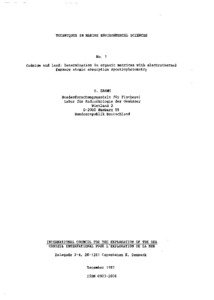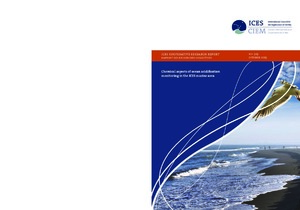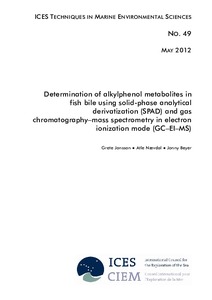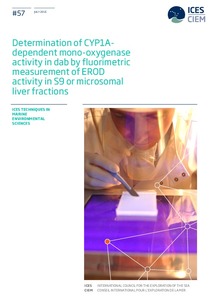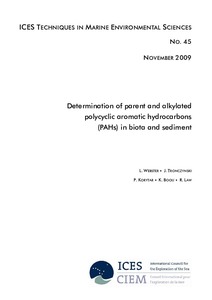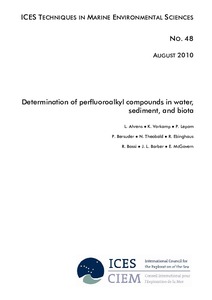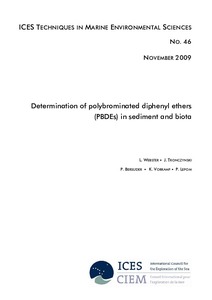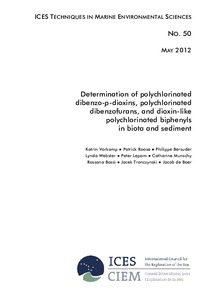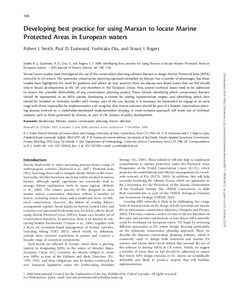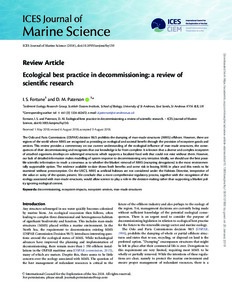Browsing ⇒ ICES: International Council for the Exploration of the Sea by Title
Now showing items 22-41 of 90
-
Cadmium and lead: Determination in organic matrices with electrothermal furnace atomic absorption spectrophotometry.
(International Council for the Exploration of the Sea (ICES), Copenhagen, Denmark, 1987)Experience has shown that atomic absorption analyses of lead and cadmium with pulsed-type graphite furnaces such as the Massmann design (Massmann, 1968) often are subject to various kinds of s ... -
Cadmium in marine sediments: Determination by graphite furnace atomic absorption spectroscopy.
(International Council for the Exploration of the Sea (ICES), Copenhagen, Denmark, 1987)Cadmium is one of the most important toxic elements to be determined in environmental samples. Cd has proved, however, to be a difficult element to determine with good precision and relative ... -
Calibration of acoustic instruments.
(International Council for the Exploration of the Sea (ICES), Copenhagen, Denmark, 2015)Acoustic sampling has long been a standard survey tool for estimating the abundance and distribution of fish, zooplankton, and their seabed habitat (Kimura, 1929; Sund, 1935; Holliday, 1972a; Nielson et al., 1980). ... -
Chemical aspects of ocean acidification monitoring in the ICES marine area.
(International Council for the Exploration of the Sea (ICES), Copenhagen, Denmark, 2013)It is estimated that oceans absorb approximately a quarter of the total anthropogenic releases of carbon dioxide to the atmosphere each year. This is leading to acidification of the oceans, which has already been observed ... -
Chemical measurements in the Baltic Sea: guidelines on quality assurance.
(International Council for the Exploration of the Sea (ICES), Copenhagen, Denmark, 2004)This document provides an introduction to quality issues, in general, and quality assurance in Baltic marine monitoring laboratories, in particular. The guidelines are intended to assist laboratories in starting up and ... -
Chlorobiphenyls in marine sediments: Guidelines for determination.
(International Council for the Exploration of the Sea (ICES), Copenhagen, Denmark, 1998)The analysis of chlorinated biphenyls in sediments generally includes extraction with organic solvents, clean-up, removal of sulphur, colullUl fractionation and gas chromatographic separation, mostly with electron capture ... -
Chlorophyll a: Determination by spectroscopic methods.
(International Council for the Exploration of the Sea (ICES), Copenhagen, Denmark, 2001)Chlorophyll a is the principal pigment in plants. As a biomass indicator of aquatic microalgae which support food webs in the sea, it is probably the most frequently measured biochemical parameter in oceanography. This ... -
Common diseases and parasites of fish in the North Atlantic: Training guide for identification.
(International Council for the Exploration of the Sea (ICES), Copenhagen, Denmark, 1996)During the past 20 years, there has been an increasing number of field surveys investigating the occurrence and distribution of fish diseases as a tool for monitoring the effects of environme ... -
Contaminants in marine organisms: Pooling strategies for monitoring mean concentrations.
(International Council for the Exploration of the Sea (ICES), Copenhagen, Denmark, 1996)Samples of marine organisms collected for contaminant monitoring are often pooled before being chemically analysed. The main reasons for pooling samples are: 1) to obtain a sufficient quantity ... -
Control procedures: Good laboratory practice and quality assurance.
(International Council for the Exploration of the Sea (ICES), Copenhagen, Denmark, 1987)Good Laboratory Practice (GLP) is one of the manifestations of the increased attention being paid to quality control measures in general. It provides a framework designed to bring the quality ... -
Determination of alkyl phenol metabolites in fish bile using solid-phase analytical derivatization (SPAD) and gas chromatography-mass spectrometry in electron ionization mode (GC-EI-MS).
(International Council for the Exploration of the Sea (ICES), Copenhagen, Denmark, 2012)This document provides advice on the analysis of alkylphenol (AP) metabolites in fish bile. APs are released to aquatic environments from many different sources related to human activities, such as offshore oil production. ... -
Determination of CYP1A-dependent mono-oxygenase activity in dab by fluorimetric measurement of EROD activity in S9 or microsomal liver fractions.
(International Council for the Exploration of the Sea (ICES), Copenhagen, Denmark, 2016)This paper describes a method for the determination of cytochrome P4501A (CYP1A) in fish liver fractions by the measurement of 7-ethoxyresorufin O-deethylase (EROD) activity. The proposed method is by fluorescent assay of ... -
Determination of Hexabromocyclododecane (HBCD) in sediment and biota.
(International Council for the Exploration of the Sea (ICES), Copenhagen, Denmark, 2010)This document provides advice on the analysis of hexabromocyclododecane (HBCD) in sediment and biota. The analysis of HBCD in sediment and biota generally involves extraction with organic solvents, clean‐up, and either ... -
Determination of parent and alkylated polycyclic aromatic hydrocarbons (PAHs) in biota and sediment.
(International Council for the Exploration of the Sea (ICES), Copenhagen, Denmark, 2010)This document provides advice on the analysis of parent and alkylated polycyclic aromatic hydrocarbons (PAHs) in total sediment, sieved fractions, suspended particulate matter, and biota (shellfish). The determination ... -
Determination of perfluoroalkyl compounds in water, sediment, and biota.
(International Council for the Exploration of the Sea (ICES), Copenhagen, Denmark, 2010)This document provides advice on the analysis of polyfluoroalkyl compounds (PFCs) in samples of water, sediment, and biota. The analysis of PFCs in these matrices generally includes extraction with organic solvents, clean‐up, ... -
Determination of polybrominated biphenyl ethers (PBDEs) in sediment and biota.
(International Council for the Exploration of the Sea (ICES), Copenhagen, Denmark, 2009)This document provides advice on the analysis of polybrominated diphenyl ethers (PBDEs) in biota and sediment. The determination of PBDEs in sediment and biota generally involves extraction with organic solvents, clean‐up, ... -
Determination of polychlorinated biphenyls (PCBs) in sediment and biota.
(International Council for the Exploration of the Sea (ICES), Copenhagen, Denmark, 2013)Polychlorinated biphenyls (PCBs) are environmental contaminants regulated by the Stockholm Convention of Persistent Organic Pollutants (POPs), and are included on the OSPAR List of Chemicals for Priority Action due to their ... -
Determination of polychlorinated dibenzo-p-dioxins, polychlorinated dibenzofurans, and dioxin-like polychlorinated biphenyls in biota and sediment.
(International Council for the Exploration of the Sea (ICES), Copenhagen, Denmark, 2012)Polychlorinated dibenzo‐p‐dioxins, polychlorinated dibenzofurans (PCDD/Fs) and polychlorinated biphenyls (PCBs) are environmental contaminants regulated by the Stockholm Convention of Persistent Organic Pollutants. Being ... -
Developing best practice for using Marxan to locate Marine Protected Areas in European waters.
(2009)Several recent studies have investigated the use of the conservation planning software Marxan to design Marine Protected Area (MPA) networks in UK waters. The systematic conservation planning approach embodied by Marxan ... -
Ecological best practice in decommissioning: a review of scientific research.
(2018)The Oslo and Paris Commissions (OSPAR) decision 98/3 prohibits the dumping of man-made structures (MMS) offshore. However, there are regions of the world where MMS are recognized as providing an ecological and societal ...
 Repository of community practices in Ocean Research, Applications and Data/Information Management
Repository of community practices in Ocean Research, Applications and Data/Information Management
